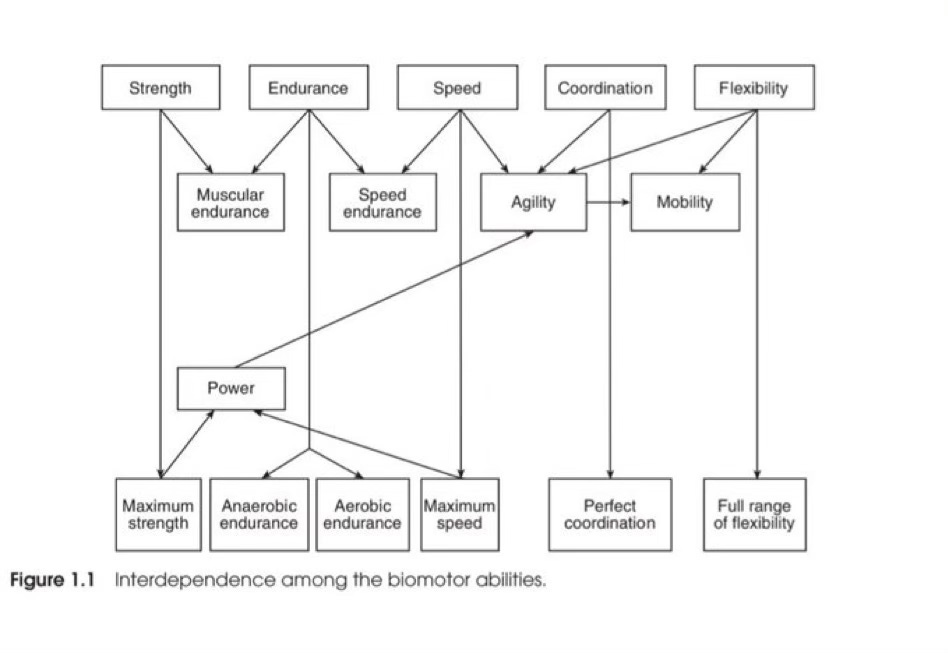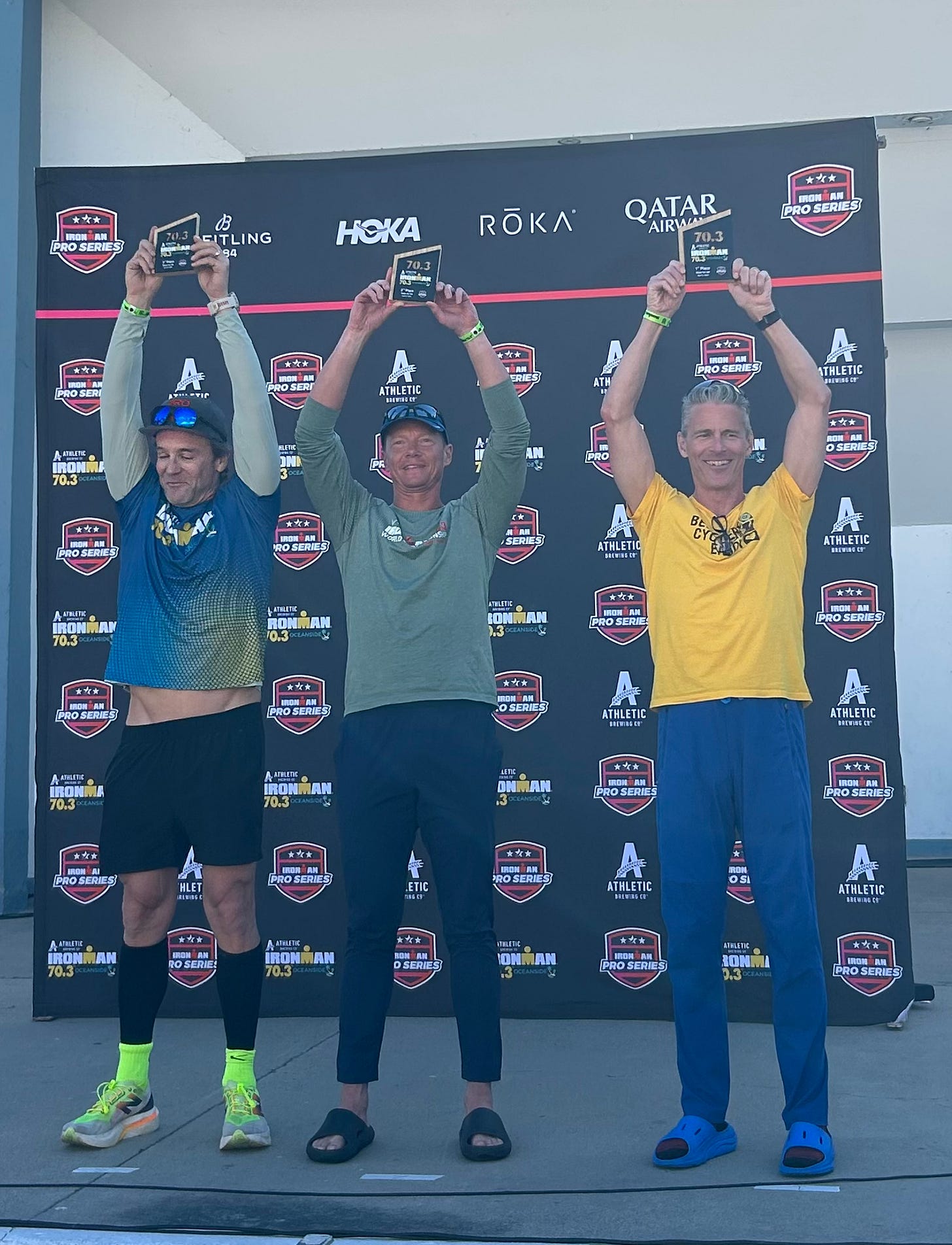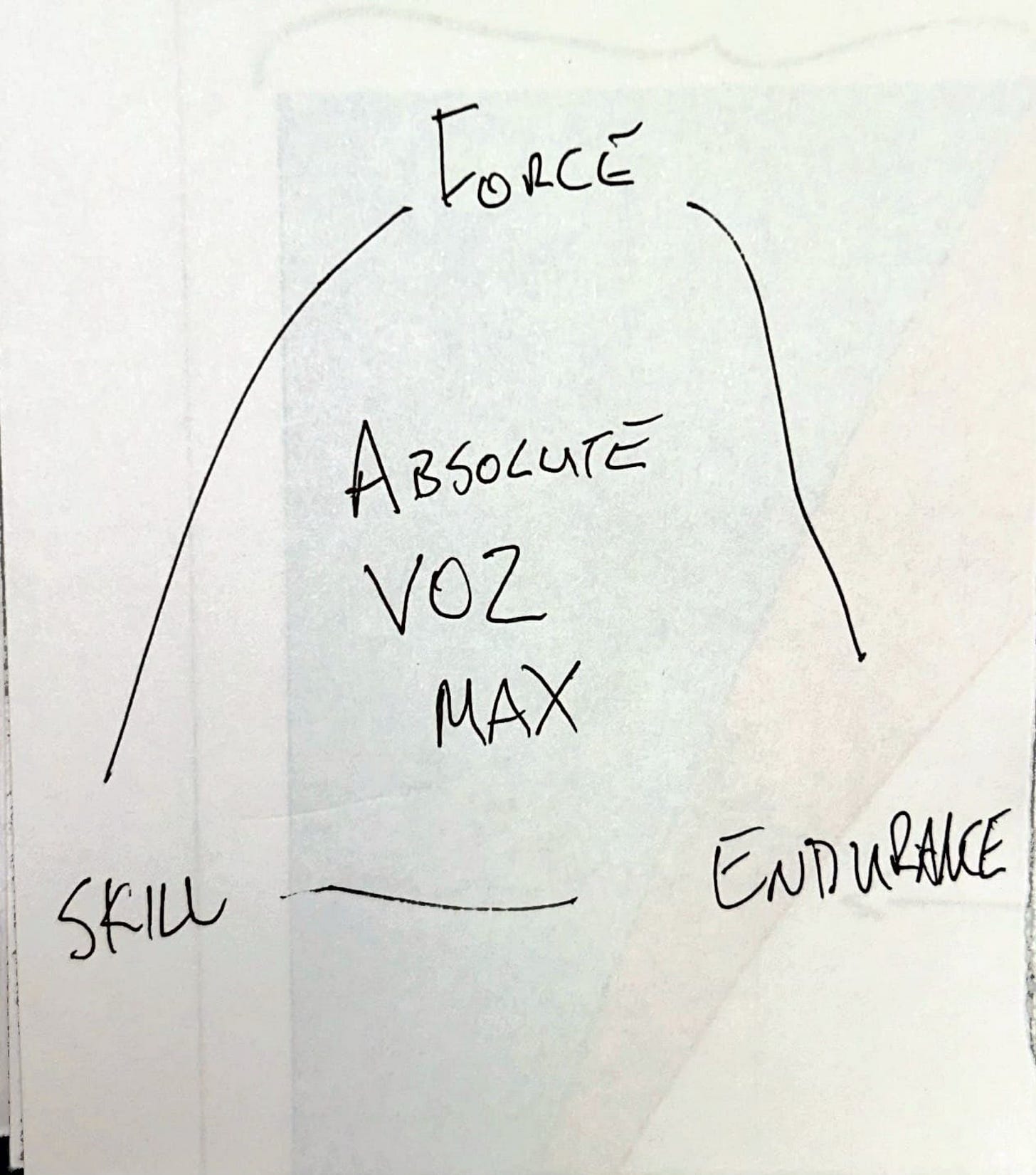I’m going to make a case that…
by consistently focusing on our Absolute VO2 Max, we can materially improve our relative performance over time.
We improve our relative performance by limiting age-related losses.
When we are in-the-moment with our current season, it can be difficult to consider (then act in the interest of) long-term performance.
Previously
In the intro piece we talked about different attributes of performance:
Force
Skill
Endurance
Force + Skill = Speed
Force + Endurance = Muscular Endurance
Skill + Endurance = Economy

Block Periodization
We talked about four themes for block periodization
Endurance and Strength - Build General Capacity
Race Specificity - Build Specific Capacity
VO2 Max - Increase The SIZE of Our Engines
Rejuvenation - Enable Long Term Upward Performance Progression
Today, I want to dig deep into VO2 Max.
Expectation vs Reality
What are your expectations with respect to a VO2 Max Block?
Pain?
Achieving Max Heart Rates?
Moving At Maximum Velocity?
These are common expectations and can limit the benefits you receive from your VO2 Block.
I want you to think differently.
First, consider is what is best for the long term development, and preservation, of your “engine.”
By “engine” I mean the absolute work rate you can generate, and sustain. This isn’t a “per kilo” relative work rate. Consider the limits to your absolute work rate. This is different from our expectations of pain and maximal power, pace and speed.
“Engine” means more than lean body mass. It’s everything (known and unknown) that goes into doing work. It includes all of our bodily systems, our mental fitness and our capacity of integrate everything towards the task of athletic performance.
Performance is measurable and our ultimate benchmark.
Ask yourself…
Assuming I had the rest of my life…
What’s necessary to increase my 6-10 minute absolute work rate?
I find it helpful to compare myself to athletes at a similar performance level. I also like to look one-level-up and consider the athletes performing better than me.
Force
Skill
Endurance
Force + Skill = Speed
Force + Endurance = Muscular Endurance
Skill + Endurance = Economy
Remember, we are thinking about absolute numbers. In a VO2 Block, if something grows our “engine” then there is no penalty for getting heavier.
What I just wrote can be a difficult thing for endurance profiles to wrap their heads around. Everything around us has a bias towards relative performance and habits1 that will shrink our “engine” over time.
Let’s consider profiles.
What type of athlete do you appear to be?
Endurance: built for long, sustained efforts. These athletes perform better the longer the duration. Slow twitch dominant, enjoys a volume and stamina emphasis.
Power: excels in short, explosive efforts. These athletes perform better the shorter the duration. Fast twitch dominant, enjoys maximal strength, speed and power training.
Hybrid: combines endurance and power for sports with mixed demands.
Above, I wrote appear to be because our bodies are highly adaptable. We don’t really know our profile until we have completed years of training, while paying attention to our results.
Generally speaking, most of us will become less explosive over time. However, if you’ve never focused on a specific attribute then you might surprise yourself.

Endurance Profiles
Let’s consider common profiles to help you decide where to focus your VO2 block.
My son (Axel) and I have similar relative VO2 Max.
However, place a pack on him and his relative performance declines far more than mine.
On the bike, he rides well uphill but can’t stay on my wheel on the flats.
Swimming, and everything else, his relative performance improves the longer the event.
His maximum heart rate is higher than his peers, perhaps due to strong mental capacity.
Last summer, we did a running ramp test. His VO2 Max was 2.7L compared to 4.5L for me. Our maximum heart rates on the test were 205 bpm vs 163 bpm.
I picked Axel because he (currently) has an endurance profile. I also have an endurance profile. However, we have different bodies.
I think of his body type as a runner’s profile:
High pain tolerance.
Lean.
Not muscular.
Able to generate, and sustain, high heart rates.
Well trained.
The question isn’t how do we move him from 2.7L to 3.0L this season. The issue is getting him from 2.7L to 5.0L by the time he’s a young adult. For Axel, we will literally need to make his engine bigger. He needs a multifaceted approach to increasing his size: energy positive, anabolic, strength & force focused.
Energy Positive - Anabolic - Strength & Force Focused
You don’t need to be a teenager to insert anabolic blocks2. I’ve done them in my 20s, 30s, 40s and 50s.
Building VO2: In my 20s, adding muscle set the stage for subsequently training that muscle via ultra running and triathlon.
Sustaining VO2: The blocks I completed in my 30s, 40s and 50s were about sustaining my absolute capacity into, then through middle age.
You don’t need to be male to insert these blocks. I coached a female athlete where our goal was to more than double her leg strength & best five-minute power, while improving her 5K time. We saw these attributes as key stepping stones on her journey towards an Ironman Hawaii qualification.
If you identify strength, force and muscular endurance are limiting your absolute VO2 Max then:
Schedule blocks where your sole goal is build your “engine.”
Remove habits of depletion.
Always fuel the work.
Your future self will thank you.
Back to The Physics of Performance
Back to Table of Contents
Next time we will discuss the Mental Side of VO2 Max as well as Power Profiles.
In the meantime, as you consider what I’ve written…
Look at your response to training, rather than what you see in the mirror. Endurance, Hybrid and Power profiles come in all shapes, sexes, ages and sizes.
Look to training response and race data, rather than historical biases. If you don’t have good data then start capturing it. Your future self will find it useful.
Remember our bodies are highly adaptable. I can present as a Power, Hybrid or Endurance profile depending on the training I’ve done for the last three years.
Be sure to include training sessions that go against your preferences, you will learn something.
A habit of depletion will not serve us well over the long term. We must fuel our bodies and train our anabolic signals. Endurance training can whittle us away, especially when combined with depletion training.
The sections I wrote inside our Strength Chapter explain anabolic blocks in detail. See: Getting Started and Phasing Your Strength.



